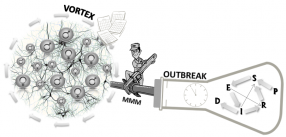 It’s been some time coming, but today I’m proud to announce a new paper of ours that has just come out in Journal of Applied Ecology. While not strictly a conservation paper, it does provide some novel tools for modelling populations of threatened species in ways not available before.
It’s been some time coming, but today I’m proud to announce a new paper of ours that has just come out in Journal of Applied Ecology. While not strictly a conservation paper, it does provide some novel tools for modelling populations of threatened species in ways not available before.
The Genesis
A few years ago, a few of us (Bob Lacy, Phil Miller and JP Pollak of Vortex fame, Barry Brook, and a few others) got together in a little room at the Brookfield Zoo in the suburban sprawl of Chicago to have a crack at some new modelling approaches the Vortex crew had recently designed. The original results were pleasing, so we had a follow-up meeting last year (thanks to a few generous Zoo benefactors) and added a few post-docs and students to the mix (Damien Fordham, Clive McMahon, Tom Prowse, Mike Watts, Michelle Verant). The great population modeller Resit Akçakaya also came along to assist and talk about linkages with RAMAS.
Out of that particular meeting a series of projects was spawned, and one of those has now been published online: Novel coupling of individual-based epidemiological and demographic models predicts realistic dynamics of tuberculosis in alien buffalo.
The Coupling
So what’s so novel about modelling disease in buffalo, and why would one care? Well, here’s the interesting part. The buffalo-tuberculosis example was a great way to examine just how well a new suite of models – and their command-centre module – predicted disease dynamics in a wild population. The individual-based population modelling software Vortex has been around for some time, and is now particularly powerful for predicting the extinction risk of small populations; the newest addition to the Vortex family, called Outbreak, is also an individual-based epidemiological model that allows a population of individuals exposed to a pathogen to progress over time (e.g., from susceptible, exposed, infectious, recovered/dead).
The problem was that Vortex and Outbreak generally operated at different time scales, such that you really couldn’t model disease dynamics well within the Vortex population framework, nor could you incorporate the complexities of population dynamics very well in Outbreak. That clever Lacy-Miller-Pollak trio figured out a way of coupling the two via something they called MetaModel Manager (MMM – about which I blogged last year) which could allow the daily step of Outbreak to run effectively within the annual step of Vortex (other breeding cycles are possible within Vortex, of course).
Buffalo-Tuberculosis
Now for the example in question, we wanted to see if we could effectively model the dynamics of tuberculosis in feral swamp buffalo (Bubalus bubalis) in northern Australia. A little background is required here.
Buffalo were introduced to northern Australia in 1826, 1827 and 1843 from Timor-Leste, and subsequently spread rapidly throughout the Northern Territory, growing to ~ 350,000 by the 1970s. Unfortunately, buffalo harboured bovine tuberculosis, which also crossed over readily to commercial cattle livestock. So the government at the time initiated a broad-scale culling programme called the ‘Brucellosis-Tuberculosis Eradication Campaign’ (BTEC) in the 1980s and 1990s. The cull successfully reduced or eradicated buffalo from major pastoral lands in the Northern Territory (taking tuberculosis with it), but since then, no follow-up culling has occurred and the population is re-invading the formerly culled areas. Although Australia now trades its livestock under the ‘TB-free’ banner, the disease is prevalent throughout Africa, southern Europe, the Middle East and parts of Asia, so in many ways, it’s only a matter of time before it rears its ugly head again here. And if it does, it could cost our cattle industry over $10 billion to fix.
The bottom line is that we need tools like Vortex-MMM-Outbreak to plan the optimal culling regimes should TB (or other, nastier diseases like foot-and-mouth) (re-)enter Australia.
The Implications
I won’t go into too many of the finer details of the paper here, although we did find that the population dynamics (especially age at first breeding) most dictated the prevalence of TB in the population – not the characteristics of the disease itself (e.g., transmission probability, incubation time, contact rate, etc.). This has HUGE implications for wildlife disease modelling in general; if one fails to incorporate the dynamics of the population in gory detail, chances are the predictions relating to the disease itself will be erroneous.
Second, we found that the probability of detecting a disease as well-known as TB was vanishingly small, such that current monitoring programmes in northern Australia done by the Northern Australia Quarantine Strategy (NAQS), a division of the Australian Quarantine and Inspection Service (AQIS), are woefully inadequate for monitoring wildlife disease in our vast northern regions.
Third, we found that if the goal was to reduce prevalence to near-zero, somewhere between 30 and 50 % of the population would have to be culled each year for about 15 years. That’s a lot of buffalo.
Now, those are really the ‘meat’ results of the paper, but I do want to re-iterate that it’s the software coupling itself that’s the most novel. In fact, part of the review process required us to model our system using ‘analogous’ software for comparison. The problem is, there just simply isn’t any customisable software out there that can do what Vortex-MMM-Outbreak can. And the best part is, it’s all free.
Yes, you can download all the software here:
- Vortex
- Outbreak
- MetaModel Manager (64-bit here)
CJA Bradshaw
-34.917731 138.603034 Advertisement Eco World Content From Across The Internet.

